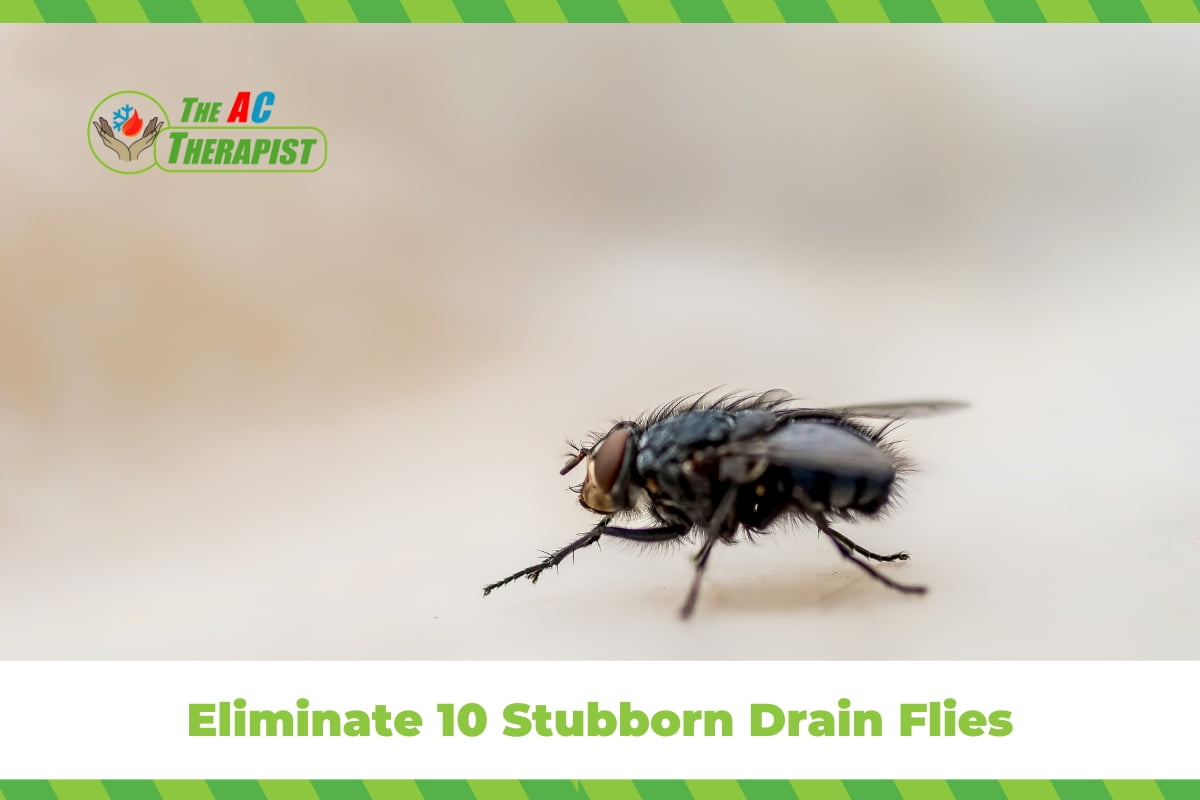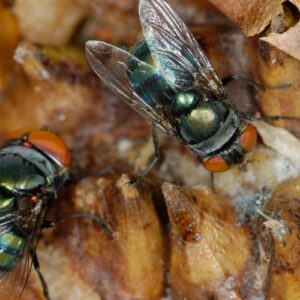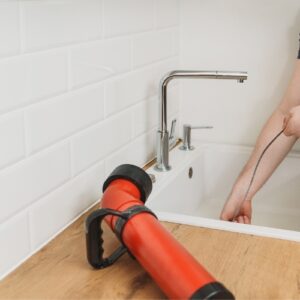Eliminate 10 Stubborn Drain Flies
Drain flies, often lurking in the shadows of our sinks, showers, and floor drains, are more than just a mere nuisance. These tiny, winged pests, sometimes referred to as moth flies due to their fuzzy appearance, can rapidly become unwelcome guests in our homes and businesses. Their presence not only signals underlying issues with cleanliness and plumbing but also poses a significant annoyance to those who encounter them. The damp, dark environments of our drains provide an ideal breeding ground for these pests, making it crucial to address an infestation promptly and effectively.
Understanding how to rid your space of drain flies involves more than just temporary fixes; it requires a comprehensive approach that tackles the root of the problem. The purpose of this blog is to arm you with a multi-faceted strategy, offering insights into preventive measures, natural remedies, and when necessary, chemical interventions. Our goal is to ensure that you can reclaim the comfort and hygiene of your living or working environments by eradicating these pests for good. Whether you’re facing a current infestation or aiming to prevent future occurrences, this guide promises to provide you with all the tools and knowledge needed to bid farewell to drain flies once and for all.
Understanding Drain Flies
Drain flies, also known as sewer or moth flies, are small, dark-winged insects that thrive in moist environments. Their name is derived from their most common breeding sites: the slimy, organic matter that accumulates in drains. Unlike other household pests, drain flies are not just a sign of unsanitary conditions but are also indicators of potential plumbing issues. Understanding these pests is the first step towards effectively managing and eliminating them from your home.
Biology and Lifecycle
Drain flies have a short lifecycle, ranging from 8 to 24 days, allowing them to multiply rapidly under suitable conditions. Their lifecycle consists of four stages: egg, larva, pupa, and adult. Females can lay 30 to 100 eggs at a time, which hatch into larvae within 48 hours. The larval stage, which lasts about 9 to 15 days, is particularly crucial, as this is when they feed on the organic matter within drains. Following this, they enter the pupal stage, emerging as adults ready to continue the breeding cycle.
Identification
Identifying drain flies is key to tackling an infestation. They are typically about 1.5 to 5 mm long, with a unique, fuzzy appearance thanks to the long hairs covering their wings and bodies, which gives them a moth-like look. They have a distinctive pattern of veining on their wings and tend to rest in a characteristic roof-like position. Drain flies are poor fliers, often seen hovering near drains, walls, and other surfaces in a jerky, short flight.
Reasons for Infestation
Drain flies infest homes for two main reasons: moisture and organic matter. They are attracted to the biofilm that forms in drains, septic tanks, and sewers, where they find both food and a hospitable environment for laying their eggs. Leaking pipes, standing water, and seldom-used drains are hotspots for drain fly activity. The persistence of these conditions can lead to repeated infestations, making it essential to address not only the symptoms (the flies themselves) but also the underlying causes.
Recognizing the signs of drain fly activity is crucial. Beyond seeing the adult flies, you might also notice a gritty, dark residue along the sides of drains or pipes — this is a biofilm, a mixture of bacteria, fungi, and other microorganisms, along with drain fly eggs and larvae. Addressing a drain fly problem effectively requires a multifaceted approach, targeting both the adult flies and their breeding grounds.
This understanding of drain flies’ biology, identification, and reasons for infestation lays the groundwork for developing effective strategies to get rid of them, which will be discussed further in the subsequent sections of this guide. By tackling the issue from multiple angles, including preventive measures, natural remedies, and chemical solutions, you can eliminate these pests and prevent future infestations, ensuring a cleaner, more comfortable living environment.
Why Drain Flies Target HVAC and Plumbing Systems
Drain flies target HVAC and plumbing systems due to the ideal breeding conditions these systems can inadvertently provide. Understanding why these environments are so attractive to drain flies helps in formulating effective prevention and treatment strategies. Here are the key reasons why HVAC and plumbing systems become targets:
Moisture and Humidity
Drain flies thrive in moist environments. Plumbing systems naturally involve water and can often have areas of standing water or leaks, which create perfect conditions for drain flies to lay their eggs. Similarly, HVAC systems, particularly those that involve condensate lines or drip pans, can collect water and become humid, offering an appealing environment for these pests.
Organic Matter Buildup
The primary food source for drain fly larvae is organic matter. In plumbing systems, this can include hair, grease, food particles, and other debris that accumulates inside drains. HVAC systems, especially those that are not regularly cleaned, can also accumulate organic matter such as dust, pollen, and other airborne particles that settle in ductwork or drain pans. This buildup provides a plentiful food source for drain flies.
Infrequent Use and Neglect
Drains or pipes that are seldom used can become prime real estate for drain flies due to the stagnant water and accumulation of organic matter. In homes or buildings where certain fixtures are used less frequently (such as guest bathrooms, utility sinks, or floor drains), drain flies can breed undisturbed. Similarly, HVAC components that are out of sight, such as condensate pumps and overflow pans, may be neglected during routine cleaning, allowing drain flies to settle in.
Leaks and Deterioration
Over time, plumbing and HVAC systems can develop leaks or areas of deterioration, which may not be immediately noticeable. These issues can create moist niches ideal for drain flies. For example, a small leak from a pipe hidden behind a wall or under a floor can create a perfect breeding ground for these pests without the homeowner’s knowledge.
Optimal Breeding Conditions
Drain flies have a very short breeding cycle, and the conditions in neglected or improperly maintained HVAC and plumbing systems can allow for rapid population growth. The combination of warmth, moisture, and available organic material in these systems creates an optimal environment for drain flies to complete their lifecycle from egg to adult in as little as a week.
Prevention and Management
Understanding why drain flies are attracted to these systems is crucial in preventing infestations. Regular maintenance, including cleaning drains, inspecting for and repairing leaks, and ensuring HVAC systems are properly serviced, can greatly reduce the risk of drain flies. For more severe infestations, professional HVAC and plumbing services can provide targeted treatments to eliminate both adult flies and larvae, addressing the problem at its source.
By acknowledging the reasons drain flies are drawn to HVAC and plumbing systems, homeowners and facility managers can take proactive steps to mitigate these pests, ensuring a healthier and more comfortable living or working environment.
Eliminate 10 Stubborn Drain Flies
Eliminating drain flies, especially when they’ve become a stubborn presence in your home or business, requires a comprehensive approach. Here are 10 effective strategies to get rid of these pests:
1. Identify and Remove Breeding Sites
First and foremost, identify where the drain flies are breeding. This could be in any stagnant water or organic buildup within drains, rarely used toilets, or even in the moisture-rich areas of HVAC systems. Once identified, thoroughly clean these areas to remove the food source and breeding grounds for the larvae.
2. Regular Drain Cleaning
Make it a routine to clean all drains with a mixture of boiling water, baking soda, and vinegar. This natural solution helps break down organic matter without the harsh chemicals that can damage your plumbing over time.
3. Use a Drain Gel
For more stubborn cases, use a bio-enzyme drain gel. These gels are designed to cling to the sides of pipes, digesting the organic material that drain flies breed in. Apply the gel before bed to allow it to work overnight without interruption.
4. Install Drain Screens
Prevent future infestations by installing drain screens. These screens catch hair, food particles, and other debris, preventing them from creating blockages and organic buildup where drain flies can breed.
5. Seal Leaks
Inspect your plumbing and HVAC systems for leaks. Even minor leaks can create damp conditions that attract drain flies. Sealing these leaks not only prevents water damage but also deters drain fly infestations.
6. Keep Surfaces Dry
Drain flies need moisture to thrive. Wiping down sinks, showers, and any other wet areas after use can help discourage drain flies from laying eggs.
7. Use Sticky Traps
Place sticky traps near suspected breeding areas to catch adult flies. This can help reduce the breeding population and give you an indication of where the main problem areas are.
8. Ventilate
Proper ventilation in moist areas, such as bathrooms and kitchens, can help reduce the humidity that attracts drain flies. Use exhaust fans regularly to keep these areas dry.
9. Regular HVAC Maintenance
For businesses like The AC Therapist, emphasizing regular HVAC maintenance can prevent conditions that attract drain flies. Ensure that condensate lines and pans are clean and flowing freely.
10. Professional Pest Control
When DIY methods aren’t enough, it might be time to call in professionals. Pest control services can offer more powerful solutions, including insecticides and industrial-strength drain treatments, to eradicate drain flies at all stages of their lifecycle.
Maintenance and Long-term Prevention
Maintaining a drain-fly-free environment requires consistent effort and preventive strategies. To ensure long-term success in keeping these pests at bay, both homeowners and businesses, including specialized service providers like The AC Therapist and Plumbing Therapist, should adopt a holistic approach towards maintenance and prevention. Here are key strategies for sustainable management and prevention of drain flies:
Regular Cleaning and Inspection
- Drains: Implement a routine cleaning schedule for all drains, including kitchen sinks, bathrooms, floor drains, and any other potential breeding sites. Use a mixture of boiling water, baking soda, and vinegar weekly to break down organic material.
- HVAC Systems: For The AC Therapist, ensuring that HVAC condensate lines and drip pans are clear and free of standing water is crucial. Regularly check these areas as part of maintenance services to prevent moisture accumulation.
Proper Waste Management
- Organic Waste: Dispose of organic waste properly and regularly. Avoid leaving food scraps or other organic materials in sinks or near drain openings.
- Garbage and Recycling Bins: Keep bins tightly sealed and emptied regularly to prevent attracting drain flies and other pests.
Structural Maintenance
- Seal Cracks and Leaks: Inspect your property for cracks, gaps, and leaks regularly. Seal any potential entry points to prevent drain flies from accessing moist breeding grounds.
- Piping and Drain Repairs: Address any plumbing issues promptly. For the Plumbing Therapist, offering regular inspection services can help identify and repair leaks or damage that could attract drain flies.
Environmental Controls
- Reduce Humidity: Use dehumidifiers in damp areas and ensure adequate ventilation in kitchens, bathrooms, and basements to keep humidity levels low.
- Standing Water: Eliminate sources of standing water inside and around your property. This includes checking potted plants, and trays under appliances, and ensuring proper drainage outdoors.
Use of Preventive Products
- Drain Covers: Install fine mesh drain covers to prevent adult flies from laying eggs in drains.
- Bio-Enzymatic Cleaners: Regular use of bio-enzymatic cleaners can help break down organic matter safely, reducing food sources for drain fly larvae without harming your plumbing.
Education and Awareness
- Staff Training: For businesses, training staff to recognize signs of drain fly activity and how to respond can be an effective part of your pest management strategy.
- Customer Education: Providing customers with tips and best practices for drain fly prevention can add value to your service offerings and help prevent future infestations.
Monitoring and Professional Assistance
- Regular Assessments: Conduct regular assessments of your property to identify potential risks or signs of drain fly activity early.
- Professional Services: Establish a relationship with professional pest control services for situations where an infestation is beyond DIY control. For The AC Therapist and Plumbing Therapist, partnering with or offering consultative pest control services can enhance your portfolio and provide comprehensive solutions to your clients.
Implementing these maintenance and prevention strategies can significantly reduce the likelihood of drain fly infestations. By focusing on the elimination of breeding sites, reducing moisture, and ensuring structural integrity, you can maintain a healthy, pest-free environment over the long term.
Winning the Battle Against Drain Flies: Comprehensive Strategies from Plumbing Therapist and The AC Therapist
As your trusted partners in home and commercial property care, Plumbing Therapist and The AC Therapist stand united in our mission to deliver environments that are not only comfortable but also healthy and pest-free. Our collaborative effort in this guide underscores our commitment to tackling one of the most tenacious and bothersome pests known to inhabit our living spaces: drain flies. With their propensity to thrive in the moist and nutrient-rich environments of our plumbing and HVAC systems, these pests have proven to be a formidable foe for many property owners. However, armed with our expert insights and a holistic approach, victory is within reach.
The journey to a drain fly-free existence is multifaceted, encompassing immediate eradication methods and embedding preventative strategies into your routine maintenance. Through the meticulous identification and removal of breeding grounds, coupled with consistent cleaning practices, we lay the groundwork for immediate relief. Yet, the cornerstone of our strategy lies in the emphasis on long-term prevention. By adopting measures such as regular plumbing inspections, ensuring optimal HVAC system performance, and fostering environments inhospitable to pests, we aim to not only address the current infestation but also shield your home from future invasions.
Our guide has navigated through the complexities of drain fly infestation, offering practical solutions ranging from natural remedies and DIY traps to the strategic use of chemical treatments when necessary. Moreover, we’ve highlighted the invaluable role of professional expertise in instances where the infestation surpasses the scope of home remedies. The AC Therapist and Plumbing Therapist, with our deep understanding of the intricacies of HVAC and plumbing systems respectively, are uniquely equipped to offer targeted interventions that address the heart of the problem.
In our pursuit of a pest-free environment, we also recognize the power of knowledge and proactive behavior. Educating property owners on the signs of drain fly activity, the importance of waste management, and the benefits of environmental controls is a vital component of our comprehensive strategy. By empowering you with the knowledge to identify and mitigate risks early, we foster a collaborative effort in pest management.
In closing, let this guide serve as a testament to our dedication to your well-being and satisfaction. The battle against drain flies may be challenging, but with the Plumbing Therapist and The AC Therapist by your side, it’s a battle you won’t have to face alone. We invite you to leverage our expertise, embrace the preventative strategies outlined, and engage our professional services when the situation demands. Together, we can secure the health and comfort of your spaces, ensuring they remain free from the nuisance of drain flies and other pests. Here’s to creating and sustaining environments where you can live, work, and thrive without the shadow of pest infestation.













